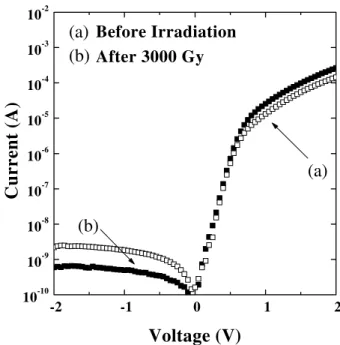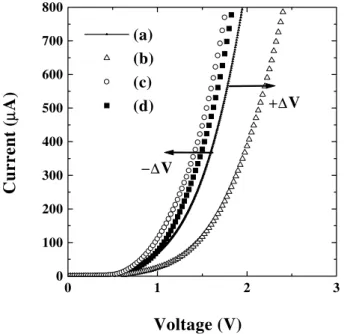A Silion-Polymer Heterostruture for Sensor Appliations
J.M. G. Laranjeira,H. J. Khoury,
Departamentode EnergiaNulear,UniversidadeFederaldePernambuo,
CidadeUniversitaria, 50740-540Reife,Pernambuo, Brazil
W.M. de Azevedo,
Departamentode QumiaFundamental,UniversidadeFederaldePernambuo,
CidadeUniversitaria, 50670-901Reife,Pernambuo, Brazil
E. A. de Vasonelos, and E.F. daSilvaJr.
Departamento deFsia,Universidade FederaldePernambuo,
CidadeUniversitaria, 50670-901Reife,Pernambuo, Brazil
ReeivedonApril23,2001
Wereportthe developmentand haraterization ofhighqualitypolyaniline-silionheterojuntion
diodesappropriatedfor useasgasand/or ionizingradiation sensors. Polyanilinethinlms40nm
thikareanativepartofthejuntionstruture,thatpresentsexellenteletrial harateristis,
withretifyingratioof50,000 at1.0 Voltbias. Thedeviesare verysensitiveto-radiationup
to6,000Gyandtogasmoisturessuhammonia,nitriaidandtrihloroethylene. Thesensitivity
of the diodes is observed through shifts of the urrent-voltage (I-V) urveswhih anbe easily
monitoredto provideaalibration urveofthe sensoreitherasaradiation dosimeteroras agas
sensorforuseinappliationsinenvironmentsdemandinggasmonitoringorradiationdosimetry.
In the last two deades onduting polymers
emergedasanewlassofmaterial foruseinadvaned
eletronidevietehnologies[1,2,3,4℄. Theireletrial
ondutivityanbehangedfrom isolatingtometalli
by hemialoreletrohemialdoping. Theeletroni
ondutivity related to the redox state (doping level)
ofthesepolymersan bemodulatedbytheinteration
withvarioussubstanes. Changesinresistane,urrent
oreletrohemialpotential,giveastraightforward
sen-sor responseofthestudiedphenomena.
Polyanilineisattrativefordevelopmentofnew
de-vies beause its eletrial properties an be hanged
by oxidation or the main hain via protonation of
the imine nitrogen bakbone, keepingits thermaland
environmental stability. Resistive polymer-based
de-vies [6, 7, 8℄ have demonstrated potential for
appli-ations as gassensing by deteting vapor of avariety
of gases. Earlyreports oneletrohemially deposited
polyaniline-silion heterojuntions [9, 10℄ desribe
de-vies with low retifyingratios(of about50), and use
relatively thik lms, yielding devies with eletrial
haraterististhatrevealandsuggesttheneedfor
fur-therimprovementondeviefabriation. Alessstudied
subjetistheuseofondutingpolymersfordosimetry
deviesdealswithondutivityhangesunderionizing
radiationexposure,butdonotexplainwhythe
ondu-tivity ofpolyaniline hanges up to ve orders of
mag-nitude [11, 12℄, when emeraldine base interats with
ionizingradiation. Coniting resultsreports either a
ondutivityinreased[11℄ordereases[12℄after
inter-ation with -radiation. Presently, there is no model
that learly explain results of the radiation eets in
thephysial and hemial properties of polyaniline or
how ionizingradiation modifythe ondutivity of the
polymers[13℄.
In this work wepresentthe development of anew
proesstoproduehighqualitypolyaniline-silion
het-erojuntion diodes and examined the performane of
the devies under exposure to ionizing radiation and
gasvapor,by meansof hanges introdued to the
de-vieeletrialharateristis.
The polyaniline-silion heterojuntions were
pro-duedby spin-oating ofpolyaniline solution onto the
silionsubstrate. A40nmlayerofpolyanilinewas
de-posited onto a n-type silion (100) substrate of
resis-tivity 1 .m. All proedures were done in a lean
roomlass1000andsubstrateleaningfollowedaRCA
proedure desribedbyof MaDiarmidetal[15℄. The
thiknessoflmsweremeasuredbyaRudolfResearh
Auto-ELIVEllipsometer. Eletrialontatswere
de-posited by vauum thermal evaporation, with the
de-vie frontontatmade ofa400nmgoldlmandthe
bak ontat of a40 nm aluminumlm. The devies
have an eetive areaof 3.610 3
m 2
and eletrial
haraterizationwasarriedoutwithaHP4155A
Semi-ondutor Parameter Analyzer. The 60
Co irradiation
sourewasa`gamma-ell'Cobalt irradiator,from
Ra-dionisLabsatadoserateof0.2742Gy/min.
Optial properties of polyaniline solution and thin
lmswere previouslystudied [14℄ toassurethedoping
stateof thepolymer. UV-visible (solution) andFTIR
(lm)spetraindiatedthatthepolymerlmisinthe
doped state[14, 16, 17℄, therefore forming a p-n
het-erojuntion with silion. The synthesis method and
spin-oatingofpolyanilineonsilionusingorganiaids
has demonstrated to yield exellent reproduibility of
the heterojuntion eletrial harateristis. For the
devies fabriated we obtain reverse breakdown
volt-ages of -70 Volts, reverse saturation urrent of 6 nA,
retifying ratio of 50,000(at 1 Volt) and ideality
fa-tor of 1.004. These parameters values are important
forsensorappliationsofthediodeforspetrometryor
dosimetryofhigh energyionizingradiation.
Figure 1showsthebehaviouroftheI-V
harater-istisofadiodebefore andafterexposureto3,000Gy
of -radiation. The main radiation eet on the
de-vie harateristi is a parallel shift in both forward
andreversebiasregions,withnofurthersignofdevie
degradation. Figure2presentsingreaterdetailthe
rel-ative hanges (I/I
o
) in forwardand reverse urrents
for -radiation doses in the range of 0-6,000 Gy. In
reversed bias onguration (urve (a)) there is a
on-tinuous inrease in urrent, linearwith dose, and the
relativehangesI/I
o
reahesupto1,400%. Thisisa
onsequeneof ionizing radiation eets assoiated to
eletron-hole pairgeneration due to interation ofthe
radiation with the polymer struture. In ontrast, in
theforwardbiasregime,thereisatransientveryrapid
inreaseinurrentandafterasmallinitialdosethe
rel-ativeurrenthangesreahes800%. Fromthereafter,
the behavior with dose is toward a urrent redution
yielding the linear behavior as shown in urve (b) of
Figure2. Theeetofradiationontheheterojuntion
ondutivityisattributedtohangesinoxidationstate
of polyaniline during irradiation with -radiation[13℄,
but the preise mehanisms are under study. These
resultssuggestthat measurementsrequiringlowdoses
(under2,000Gy)andhighsensitivityouldbedonein
thereversed biasmode,while higherdoses(over2,000
Gy) ouldbemonitoredintheforwardbiasondition,
-2
-1
0
1
2
10
-10
10
-9
10
-8
10
-7
10
-6
10
-5
10
-4
10
-3
10
-2
(b)
(a)
(b)
(a)
Before Irradiation
After 3000 Gy
C
u
rrent (A
)
Voltage (V)
Figure 1. I-V harateristis of the heterojuntion diode
priorandafterexposureto3,000Gyof-radiation.
Thepotentialof using the heterojuntion as a gas
sensor is illustrated in Figure 3. The diodes were
ex-posedtodierentgasesanditseletrialresponse
mea-suredasafuntionof exposuretime. Curve(a)
repre-sentsthevirgindiode, priortovaporexposure. Curve
(b) istheresultingI-Vharateristi afteroneminute
exposure to ammonia. The forward harateristi is
strongly shift positively relative to urve (a) (+V),
and this behavioris found to belinear within the
ex-posure time interval of 0-5 minutes. Larger exposure
time leadsto largerpositivevoltageshifts,andwe
ob-servedthat thedevie response ishighly sensitiveand
fast. Eletron donating gases like ammonia interats
with the polymer and redues the arrier density of
polyanilinelm,towardsaresistaneinrease. The
re-sponsesofthedevietotrihloroethylenefor5minutes
(urve()) andnitri aidfor1minute(urve(d))are
also presented. The responses arequitedierentfrom
ammonia. Theforwardharateristishiftsnegatively
relativeto urve (a)( V) asafuntion of exposure
time,howeverthelineardependenewithexposuretime
remainsunhanged. Alldeviesalsopresentahigh
sen-sitivity, and relativeurrent hanges reahes54 %,68
%and17%respetivelyforammonia(1minute),nitri
aid(1minute)andtrihloroethylene(5minutes),at2
Voltsbias. Here,protoniaidsinreasethearrier
den-sityofthepolyaniline thinlm andthereforederease
the resistane through the heterojuntion. The
poly-mer interation with trihloroethylene vapors an be
explained due to slow deomposition of
trihloroethy-lene with subsequent formation of hydroloridi aid
underlightationandinpreseneofthemoisture. We
varietyofothergasesassoiatedwithombustion
emis-siontounveilfurtherappliationsofthisdevieto
on-tamination andenvironmentalemissionontrol.
0
1
2
3
4
5
6
7
0
300
600
900
1200
1500
1800
(a)
(b)
Reverse Bias
Forward Bias
Dose (10
3
Gy)
∆
I/
I
O
(%
)
0
200
400
600
800
1000
∆
I/
I
O
(%
)
Figure 2. (a)Reverse and (b)Forward relative hanges in
urrentunder-radiationdosesintherange0-6,000Gy
0
1
2
3
0
100
200
300
400
500
600
700
800
−∆
V
+∆
V
(a)
(b)
(c)
(d)
Voltage (V)
C
u
rrent (
µ
A)
Figure 3. Current-voltage urves (a) prior to exposure,
and after exposureto (b) ammonia for 1 minute, ()
tri-horoethylenefor5minutesand(d)nitriaidfor1minute.
In summary, a proess to produe high quality
polyaniline-silion heterostruturediodes hasbeen
de-veloped. Thedevies present exellenteletrial
har-ateristis,withapparentbarrierhighof0.58volts,
re-versebiasurrentof6nA,idealityfatorof1.004and
retifying ratio of 50,000 at 1.0 Volt. Exposure to
-radiationalterstheforwardand reverseurrent
het-erojuntion harateristis and a linearbehavior with
radiationdoses intherangeof0-6,000Gyindiate the
area. Exposingthediodestogasmoistureofammonia,
nitriaid,andtrihloroethylenealsoalterslinearlythe
diode forward harateristis. The behavior observed
intheforwardandreverseharateristisofthediodes
are assoiated to hanges of eletrial ondutivity of
thepolyanilinethin lm and/orgasvaporadsorption.
Theresultsstronglysuggestthistypeofheterojuntion
asapromisingdeviestrutureforremotesensingofa
varietyofgasesandhigh energyionizingradiation.
Aknowledgments
Theauthorsarethankfultothenanialsupport
re-eivedduringthedevelopmentofthisworkfromCNPq,
PADCT/FINEP under ontrat# 77.97.1120.00, and
CTPETRO/FINEPunderontrat#65.00.02.80.00.
Referenes
[1℄ H.Tomazawa, D. Braun,S.Phillips, A. J.Heeger and
A.H.Kroemer,Synth.Met.,22,63(1987).
[2℄ H. Koezuka, and A. Tsumura, Synth. Met., 28, C753
(1989).
[3℄ G.Gustafsson,G.M.Treay,Y.CaoandA.J.Heeger,
Synth.Met.,55-57,4123(1993).
[4℄ J.C.ChiangA. G.MaDiarmid, Synth.Met.,13,193
(1986).
[5℄ J. W. Gardner, P. N. Bartlett K. F. E. Pratt, IEE
Proeedings-Ciruits Devies and Systems, 142, 321
(1995).
[6℄ A.Boyle,E.GenisandM.Lapkowski,Synth.Met.,28,
C769(1989).
[7℄ C.Conn,S.Sestak,A.T.BakerandJ.Unsworth,
Ele-troanalysis,10,1137(1998).
[8℄ E.W.Paul, A.J.Rio, M. S.WrightonandY.
Nish-ioka,J.Phys.Chem.,89,1441(1985).
[9℄ Y. Renkuan, Y. Hong, Z. Zheng, Z. Youdou and W.
Yongan,Synth.Met.,41-43,731(1991).
[10℄ Y.Renkuan,L. Yuxue,Y. Hong, W.Yongbin, Z.
Xi-angqinandX.Jian,Synth.Met.,55-57,4087(1993).
[11℄ Q.Yao,L.LiuandC.Li,PolymerBull.,31,601(1993).
[12℄ M.Wolszzak, J. KrohandM. M. Abdel-Hamid,
Ra-diat.Phys.Chem.,45,71(1995).
[13℄ W. M. de Azevedo, A. P. Lima, E. S. Araujo, Rad.
Prot.Dosimetry,84,1(1999).
[14℄ J.M. G.Laranjeira,H.J.Khoury,W.M. deAzevedo
and E. F.da SilvaJr., Annalsof the V Enontro
Na-ionaldeAplia~oesNuleares,5,N.1,p.154-158(2000).
[15℄ A.G.MaDiarmid,J.C.Chang,A.F.Rihter,N.L.
D. Somasiri and J. Epstein, in Conduting Polymers,
Ed.L.Alaer,ReidelPubl.Co.,105(1987).
[16℄ M.K.Ram,G.Masetti, S.Paddeu,E.Maioni and
C.Niolini,Synth.Met.,89,63(1997).
[17℄ J.Tang,X.Jing,B.WarigandF.Wang,Synth.Met.,

